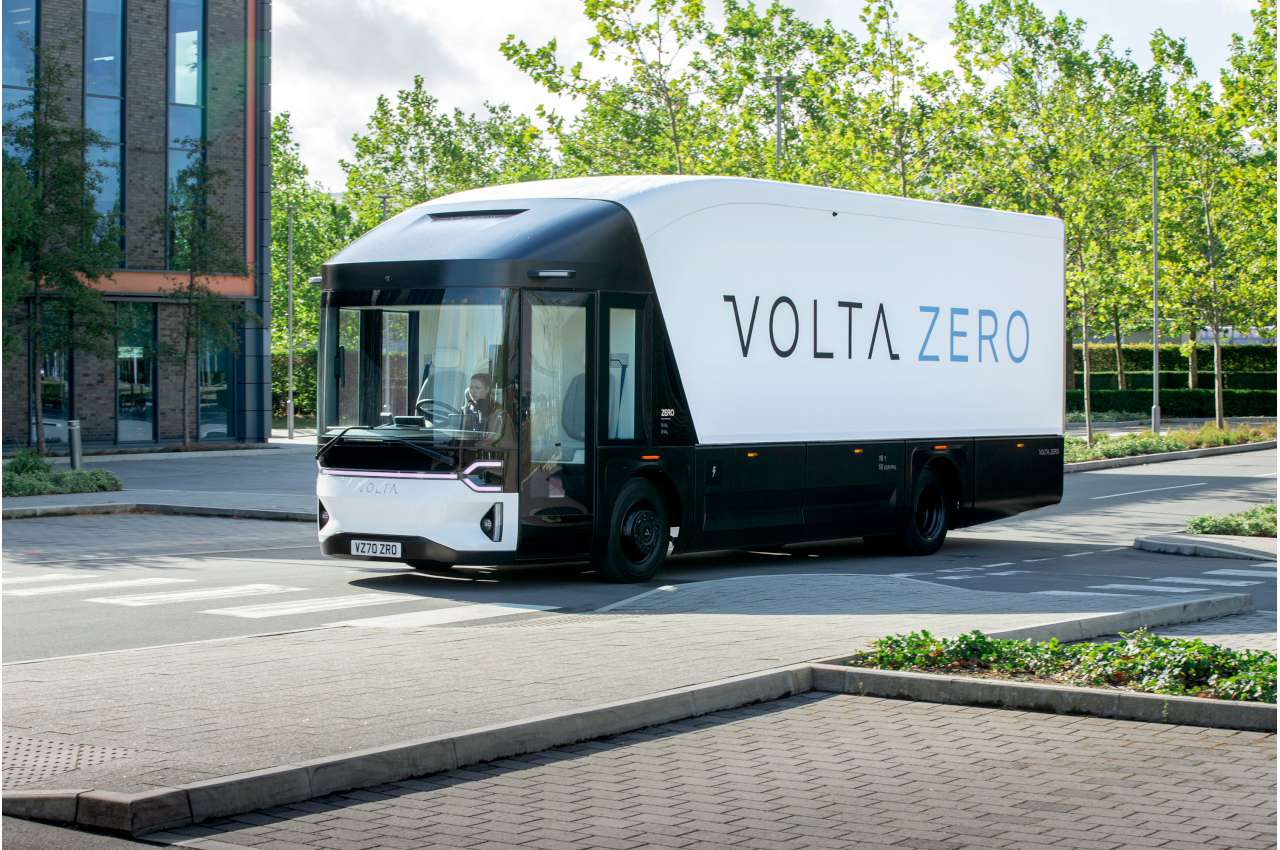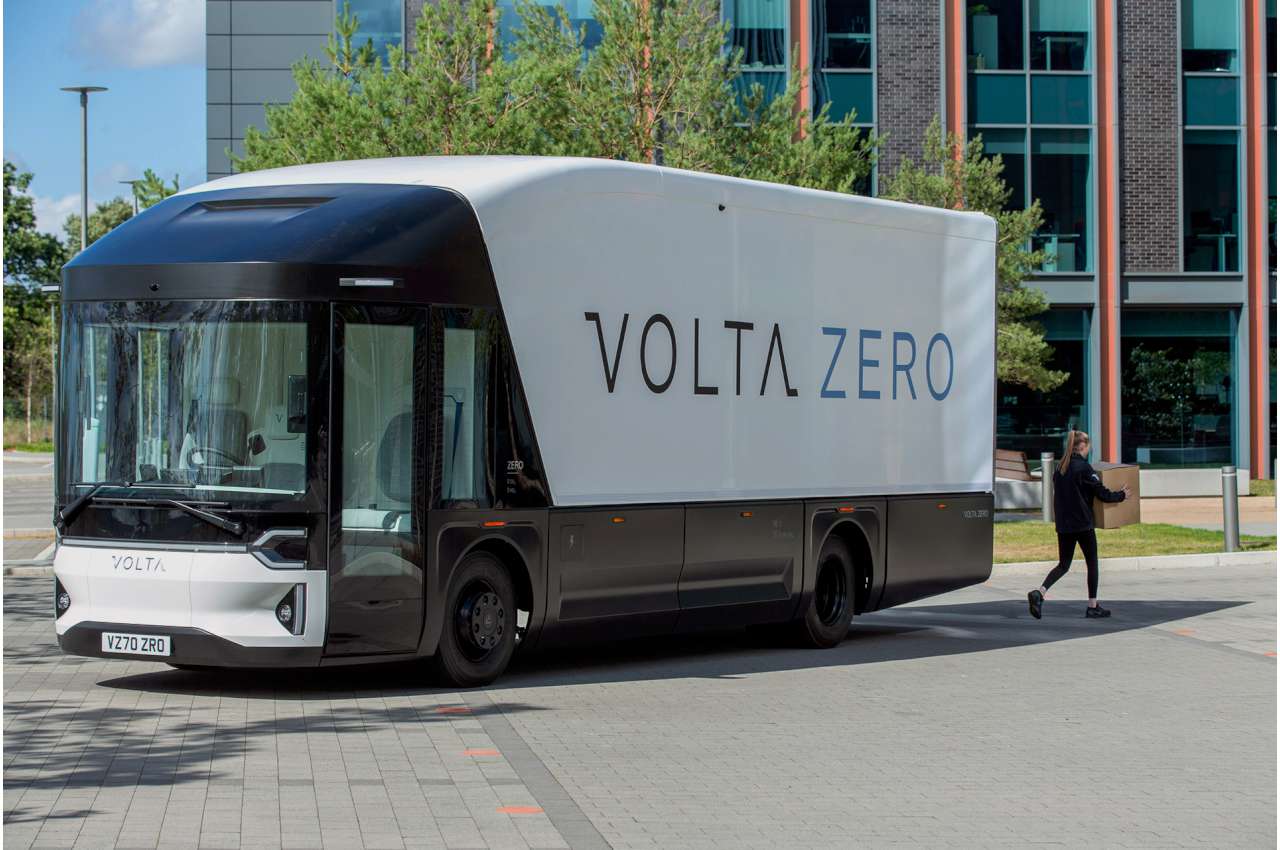The first prototype of the Volta Zero has gone on show and appears to tix all the boxes. The hardest part will be to ramp up to full production, as the company is using an outsourcing model. With a headcount of just 16 at present, mainly in the UK, the company plans to have 150 people in place by the end of next year with full manufacturing of the trucks starting in 2022.
The Volta Zero
The advantage of designing a brand new truck with a totally blank sheet of paper and the use of a fully electric driveline means that modern safety concepts can be included easily.

For this reason, the driver sits low down – roughly at pedestrian head height and has a 220 degree direct view outside the cab. This panoramic view of the surroundings through a glasshouse-style cab is designed to deliver a Transport for London five-star Direct Vision Standard rating for optimum visibility and the reduction of blind spots. The protection of vulnerable road users is also enhanced by the use of rear-view cameras that replace traditional mirrors, a 360-degree birds-eye camera showing the driver their complete surroundings, and blind-sport warning systems that detect objects down the sides of the vehicle.
Safety is at the heart of the Volta brand for one simple reason. In London, as an example, 23% of pedestrian fatalities and 58% of cyclist deaths involve an HGV, yet large trucks only account for 4% of road miles. This is clearly unacceptable and must change. The Volta Zero completely reimagines the commercial vehicle, ensuring it can operate safely with all road users and become a friend of the zero-emission city.
Carl-Magnus Norden, Founder of Volta Trucks.
To help the driver get in and out, there is a central driving position with a swivel seat. Drivers have easy access through fast opening sliding doors on either side of the cabin to enter or exit either side of the vehicle into the busy or narrow streets.
The truck will offer the latest Advanced Driver Assistance Systems (ADAS). ADAS electronic systems help driving, safety, manoeuvring, and parking, and make a significant contribution to the safe operation of larger vehicles.
The driver of a Volta Zero will benefit from technologies such as Active Steering, Road Sign Assist, and Reversing Assistant with reversing camera, ensuring they have the latest safety support systems when operating in the confines of the city centre. While on the move, Lane Change Assist and Lane Departure Warning systems ensure that the truck operates as safely as possible. The vehicle’s operator also benefits from a technical status monitoring system, based on artificial intelligence, that avoids breakdowns and maximises the uptime of the vehicle.
With a payload of 8,600kgs, an overall volume of 37.7m 3 and is designed to accommodate 16 Euro pallets the truck should be able to cope with most local distribution needs. A refrigerated cargo box will also be available, without reducing overall volume as a result of the vehicle design. Volta Trucks is integrating the use of the vehicle’s battery for the cooling and refrigeration unit of the cargo box that’s normally diesel-powered, thus further reducing CO 2 or particulate emissions from commercial vehicle operations.
The Volta Zero is 9,460mm in length, 3,470mm high and 2,550mm wide, with a wheelbase of 4,800mm. It’s Gross Vehicle Weight is 16,000kgs and the vehicle is limited to a top speed of 90km/h (56mph).
Made of Tough Stuff
The Volta Zero will be the first road vehicle to use a sustainably sourced natural Flax material and biodegradable resin in the construction of exterior body panels, with the cab’s dark body panels and many interior trims constructed from the natural material. The high- tech Flax weave was developed by Bcomp of Switzerland, in collaboration with the European Space Agency, and is currently used in 16 of the world’s most competitive motor racing series.
The Flax weave is reinforced with Bcomp’s patented powerRibs™ grid technology. The result is a fully natural, extremely lightweight, high-performance fibre matting that is almost CO 2 neutral over its lifecycle. It also matches the stiffness and weight of carbon fibre but uses 75% less CO 2 to produce. The Flax matting is combined with a biodegradable resin by composites manufacturer, Bamd in the UK, to produce the body panels for the Volta Zero. The fully bio-based resin, derived from Rape Seed oil, creates a naturally brown coloured matting and a black natural pigment dye is added to complete its darker, technical appearance.
At the end of their useful life, the Flax composite parts can be burnt within the standard waste management system and used for thermal energy recovery, unlike alternative composite materials that are usually sent to landfill.
This material is also safer for vehicles operating in inner-city environments. Should an accident occur, the Flax composite bends, reshapes and ultimately snaps, offering a flexible fracture behaviour without sharp edges. This reduces the risk of sharp debris that can injure people or cause further accidents through punctures.
Should an incident occur, thanks to the cab’s inner metal spaceframe structure, simulations have shown that this pioneering hybrid use of composite body panels has the same crash and safety performance as conventional steel material.
Range Anxiety
The real-world operating range of an electric commercial vehicle is a make-or-break decision in its effectiveness on an operator’s fleet. When the Pilot fleet vehicles are driving on the streets of the world’s largest metropolitan cities during 2021, the Volta Zero will offer a pure-electric range of 95 – 125 miles. This should be more than sufficient for the daily use of a ‘last-mile’ delivery vehicle and has been validated using simulations with a fall payload.
Volta Trucks will be the first full-electric large commercial vehicle manufacturer in Europe to use an ‘e-Axle’ to drive the rear wheels, rather than the conventional electric motor and driveshaft set up used by the small number of other electric truck manufacturers. The single electric motor, transmission, and axle of the Volta Zero are contained in a lightweight and compact e-Axle unit that’s lighter and more efficient, delivering an increased range as a result. It also provides packaging benefits by freeing up space between the chassis rails. This is where Volta Trucks fits the battery of the vehicle.
The Batteries
The Volta Zero will use 160 – 200 kWh of battery power, and the company has selected to fit the vehicle with Lithium Iron Phosphate batteries instead of a Nickel Cobalt Manganese set up used in most passenger cars. The Lithium Iron Phosphate battery will be highly modular, enabling Volta Trucks to adapt the vehicle to an operator’s specific requirements.
The Lithium Iron Phosphate battery technology is well suited to large commercial vehicle use. It delivers a long cycle life, robust cell design, and good thermal stability, enhancing safety. Located between the chassis rails, the battery is as far away from an accident as possible. Should the vehicle be involved in a significant accident that punctures a battery cell, the Lithium Iron Phosphate battery is very stable and does not ignite. By contrast, should a Nickel Cobalt Manganese battery cell be punctured, they can burn at extremely high temperatures. With commercial vehicles operating within public and depot environments, the use of Lithium Iron Phosphate negates these significant safety and insurance challenges.

‘Truck as a Service’ Offer
In the same way that we no longer own and buy our computer software, Volta is proposing the same system for their Zero. We might call it leasing.
According to Volta, ‘Truck as a Service’ “offers fleet managers a frictionless and hassle-free way to electrify their fleet of vehicles, and also provides a ‘helping hand’ to smaller operators with fewer vehicles who know they need to migrate to electric commercial vehicles, but might be daunted by the challenge. Truck as a Service will help them with every step by offering a single, affordable, monthly fee that provides access to a full-electric Volta Zero vehicle, and all of its servicing, maintenance, insurance and training requirements. It will even provide a replacement Volta Zero when needed, maximising the uptime and operational efficiency of the vehicle.”
Due to its innovative electric powertrain, the Volta Zero has 90% less mechanical parts than an equivalent internal combustion engine vehicle. As a result, Volta Trucks is targeting the same Total Cost of Ownership as equivalent diesel-powered vehicles, providing a further incentive towards the migration to electric vehicles.
In H1-2021, Volta Trucks will embark on the next stage of development, being the production of 12 pilot fleet vehicles. These vehicles will be built in the UK and used for testing and evaluation with a number of Europe’s leading logistics companies to provide operator input and feedback on the final production specification.
Production of the Volta Zero is due to commence in 2022 and investigations are ongoing to secure a contract manufacturing partner to assist with production. Production is anticipated to be in the UK. By the end of 2022, Volta Trucks aims to have built around 500 customer-specification vehicles, rising to 5,000 vehicles a year by 2025, and increasing thereafter.
Volta Trucks – the background.
Volta Trucks was formed in Sweden by co-founders, Carl-Magnus Norden and Kjell Walöen. It retains its head office in Stockholm, Sweden but most of its business operations are undertaken in the UK, where its Chief Executive Officer, Rob Fowler, and Management Team is based. As a start-up that is supported by a number of out-sourced partners and consultants, Volta Trucks currently has a core management and operating team of 16 in Sweden and the UK. During 2021, Volta Trucks will develop a UK Head Office and aftersales facility in a West London location to service the vehicles that will operate in the pilot trials in London. By the end of 2021, it is anticipated that the Volta Trucks will have created about 130 skilled automotive and engineering jobs, with its headcount risen to around 150 people.
